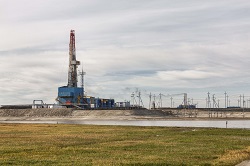- Home page /
- New technologies and equipment /
- Gazprom Neft undertakes first ever 15-stage fracking...
Gazprom Neft undertakes first ever 15-stage fracking operation
 |
| Courtesy of gazprom-neft.com |
The Gazprom Neft Group’s first high-volume 15-stage fracked horizontal well has been brought into production by Gazpromneft Khantos: such high-level multi-stage fracking having been made possible through the use of non-ball-and-socket well completion and stimulation technology.
Multi-stage fracking operations at the Yuzhno-Priobskoye field well were undertaken as part of the company’s activities in the development of hard-to-recover oil reserves. Running to a total well depth of 4.2 kilometres, horizontal drilling comprised 760 metres. The key feature of the configuration of the horizontal section of the well lies in its allowing well stimulation to continue throughout its entire operation, removing any limitations on the number of fracking operations that can be undertaken.
Once development is complete, the well’s operational potential is expected to reach at least 75 tonnes of oil per day – exceeding comparable figures for lesser multi-stage fracking operations by at least 10 percent. The implementation of innovative technologies here not only makes possible greater well output, but will, in the longer term, also lead to a greater proportion of hard-to-recover reserves being brought into development.
Vadim Yakovlev, First Deputy CEO, Gazprom Neft, commented: “The use of cutting-edge technologies is an absolute priority throughout the entire Gazprom Neft Group. In 2015, in particular, we expect to see group-wide horizontal drilling volumes increasing by 12.5 percent, to 334 wells, with the number of high-technology wells completed with multistage hydraulic fracking increasing by more than 40 percent this year, to 238.”
Sergey Doktor, CEO, Gazpromneft-Khantos, commented: “Gazpromneft-Khantos’ strategy is envisages increasing production, including by bringing hard-to-recover oil reserves into development, reducing operating costs, and promoting technological developments. Introducing innovative technologies throughout our facilities ensures the successful fulfilment of these objectives.”
The key feature of this new technology, predominantly, lies in isolating the frac ports (the points inside the well from which fracking is expected to be undertaken) from each other. Under more traditional “ball-and-socket” technology, each new fracking zone is separated from the preceding one by a metal (or composite) ball. The diameter of these balls increases from zone to zone, with the result that the way these wells are constructed makes more than 10 fracking operations impossible. Multistage fracking at the Yuzhno-Priobskoye field did not involve using balls as isolators, but, rather, a special instrument with a multiuse compacted “cushion”, which expands to isolate those areas in which fracking has been completed. Once work has been completed this deflates to its normal size and can be transported to the next area of the well from which fracking is to take place – in contrast to the more traditional balls, which have to be destroyed once fracking is completed. In which circumstances, the number of fracking operations is limited only by the extent of the well itself, and by technical and economic considerations. In addition to which, and, again, in contrast to more traditional technologies, this method allows research to be undertaken from within the well, as well as allowing repeated fracking and the quick commencement of production once all fracking operations have been completed.
Source: gazprom-neft.com

